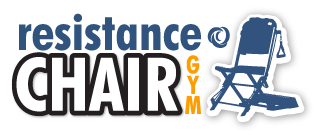The following information has been taken from VQ Actioncare in regard to shoulder and/or rotatorcuff injury and the use of the Resistance Chair. Please look for additional injury series blogs following this one soon. You can also see the exercises for these specific injuries here while using the Resistance Chair Exercise System and it's accessories. We here at ResistanceChairGym.com want to provide you with all the information possible to help you with your journey into a healthier, happier you using the Resistance Chair!
Shoulder Pain Rehabilitation Protocol
- Rotator Cuff Syndrome
- Shoulder impingement
The Resistance Chair Solution:
a. General Information:
Shoulder impingement is one of the most common
causes of shoulder pain in older adults. The rotator cuff
tendons (most commonly the supraspinatus muscle) and/
or shoulder bursa (fluid filled sac that acts as a cushion)
become inflammed when compressed between the
bones in the shoulder (scapula and humerus). Patients
often report soreness and pain, especially with overhead
activities. If left untreated, the rotator cuff tendons can
weaken and possibly tear or even rupture. Patients may
also lose range of motion due to pain and disuse. The
rehabilitation approach includes: focused strengthening of
the shoulder stabilizing muscles to improve mechanics,
improving the stability of the shoulder motion to resolve
tendon and bursa irritation, and restoring range of motion
with proper stretching when necessary.
b. Causes:
- Overuse, especially with repetitive lifting
- Poor mechanics when performing shoulder activities
- Shoulder instability (muscle imbalance/weakness)
- Poor posture. Slumped posture and/or weakened back muscles cause the shoulder
- blade to tilt forward, exacerbating the impingement.
- Injury/Trauma
- Degenerative arthritis
c. Symptoms:
- Pain in the front, top and/or side of the shoulder and upper arm.
- Increased pain with raising the arm overhead.
- Pain increased with lifting or reaching behind your back.
- Tenderness over the upper outside part of the shoulder.
- Decreased strength if left untreated.
- Pain at night impairing sleep when lying on the affected arm.
d. Management
A physician may diagnose this condition based on one’s symptoms and clinical exam.
Treatment may include medication (NSAIDs such as Ibuprofen), ice, rest with activity
modification (avoiding overhead lifting and related pain inducing activities), and a
specific rehabilitation program (often with physical therapy) to reduce inflammation. In
more severe cases a steroid injection may help to reduce swelling and pain. Surgery
may be indicated when conservative treatment fails.
e. The Resistance Chair Solution
The Resistance Chair Solution rehabilitation program includes: focused strengthening
of the shoulder stabilizing muscles to improve mechanics, improving the stability of the
shoulder motion to resolve tendon and bursa irritation, and restoring range of motion with
proper stretching when necessary. The program also corrects postural abnormalities and
balances the rotator cuff musculature for proper shoulder stabilization.
Technique Key: Sit upright, ensuring proper posture, with shoulders relaxed away from
ears and make sure to breathe continuously through exercises.
